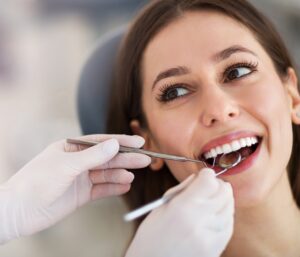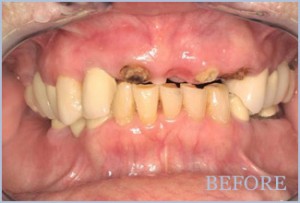Header logo
header top contact widget
Systemic Inflammation
New Studies Reinforce Obesity-Gum Disease Connections
Posted on Apr 01, 2022 by William J. Claiborne, DDS MS
The first quarter of 2022 has concluded. If your New Year’s resolution to lose weight has waned by now, here’s an incentive to hopefully recommit to it. Researchers at Case Western Reserve University School of Dental Medicine recently conducted a study that found the human body with fewer fat cells is better able to combat periodontal (gum) disease. This is because fat cells trigger inflammation in the body.
In the study, 31 obese people who had clear indications of gum disease were monitored. Half of the group had gastric bypass surgery with fat cells removed from the abdomen. Those in the other group had not had gastric bypass surgery or fat removed.
Researchers noted that the majority of the bypass surgery group had a drop in their glucose levels following the procedure. This is a positive outcome based upon the higher risk of overweight people for diabetes and insulin-related problems.
All study participants underwent non-surgical periodontal treatments and were provided oral hygiene instructions for at-home care. While both groups showed improvement, the surgery group had better results.
https://www.sciencedaily.com/releases/2011/11/111109111540.htm
Inflammation in the body that continues without being able to resolve itself is known as systemic inflammation. This can have harmful effects over time, even eroding bone and that can lead to tooth loss. The inflammation can also cause breaks in the gums where harmful oral bacteria can enter the bloodstream. The potent bacteria of periodontitis (advanced gum disease) have been linked to preterm birth, stroke, heart disease, some cancers, diabetes and arthritis.
Years of scientific studies have long shown that insulin levels in diabetics improve when their gum health improves. Not surprisingly, the pathological processes that occur in both gum disease and rheumatoid arthritis (RA) are almost identical. Both have similar clinical structures, which are agents that cause disease or illness.
Based on the clinical makeup of gum disease and arthritis, the genetic similarity causes both conditions to cause chronic inflammation in tissues that connect to bone. It has also been shown that, by treating periodontal disease in RA patients, symptoms often improve. This has been attributed to a reduced burden of oral inflammation to the system.
Because excessive fat cells cause insulin to be more resistant to function as needed, a higher accumulation of sugar in the blood (hyperglycemia) occurs. By losing weight, insulin becomes less resistant and improves the diabetic status. Similar to improving inflammation levels in arthritic joints, gum disease treatment can also calm the inflammatory load from being overweight.
Another influencer of inflammation the researchers noted is the presence of the leptin hormone. This hormone is what regulates metabolism. Leptin has been linked to inflammation by increasing the production of a particular protein, which is also linked to inflammation (having a domino effect, of sorts). Because leptin production is reduced after bariatric surgery, the levels of inflammation are lower with better outcomes in periodontal treatment.
https://www.sciencedaily.com/releases/2021/11/211112083106.htm
In yet another recent study, the inflammation caused by obesity appeared to be a trigger for the development of cells that break down bone tissue. Natural teeth are held in place by the upper and lower jaw bone. To improve the understanding of the obesity-gum disease connection, research conducted at the University at Buffalo examined two groups of mice over a 16 week period. The mice were fed vastly different diets. The mice in one group were fed a low-fat diet (10% fat). In the other, the diet consisted of 45% fat, nearly half of that fed.
The high-fat diet group experienced obesity as well as higher inflammation and less bone mass where teeth are held in place. The researchers also noted that excessive inflammation resulting from obesity causes the cells that break down bone tissue. These cells, which originate in bone marrow, increase during illness in order to regulate immune function.
Bone loss is a leading symptom of gum disease, often leading to tooth loss. Gum disease affects nearly half of American adults ages 30 and older, according to the Centers for Disease Control & Prevention (CDC).
In NC, according to 2020 statistics, the CDC also reported that the obesity level of adults ages 30+ was 33.6. That’s one-third of our state’s population being obese. (https://www.cdc.gov/obesity/data/prevalence-maps.html#overall)
The relationship between the degree of obesity and gum disease is clear. However, as a periodontal specialist, I hope continued studies on the inflammation-bone connection that accompanies obesity (such as arthritis and osteoporosis) can improve the health of our U.S. population.
So, is the message here to improve your weight by improving your oral health? Research is certainly finding that one helps the other. After all, being at a healthy weight should make you smile, and we all want a smile that shows our confidence and overall well-being.
Know the common symptoms of gum disease and respond promptly by seeing a periodontist. Symptoms can include puffy gums that turn red in color; inflamed, swollen, or bleeding gums; gums that loosen from the base of teeth; persistent bad breath; gums that become spongy and bleed easily; and, pus pockets that form on the gums at the base of teeth.
If you are experiencing any of these, please contact our Asheville periodontal dental office. If dental fear of anxiety has prevented you from having regular dental care, we will be happy to discuss features such as oral and I.V. sedation (“twilight sleep”). Too, our office offers some of the most advanced dental technology in the Southeast. These options often save the patient much time in treatment, improve outcomes, and enhance comfort.
Call 828-274-8448 to begin with a consultation appointment. A referral is not necessary.
ED Risks Higher With Presence of Gum Disease
Posted on Feb 25, 2022 by William J. Claiborne, DDS MS
For over two decades, medical researchers have closely focused on inflammation in the body and its power to activate health problems, heart and cardiovascular diseases in particular.
It has been determined that inflammation anywhere in the body can set off a series of biochemical changes in the bloodstream; those that are designed to help the body repair inflamed tissues. However, when inflammation becomes chronic, blood chemistry never returns to normal, and trouble ensues. Researchers have noted this significantly in its increased risk of heart attack and stroke.

Think of chronic inflammation as a pan of water that is boiling on the stove. When the body is in proper control, the boiling process ceases when the stove is turned to “off.” In chronic inflammation, however, the water continues to boil even after the pan is removed from the stove top.
Chronic inflammation can exist in the mouth, set at a constant “boiling point” due to advanced gum disease (known as periodontitis). Common symptoms are puffy gums that turn red in color; inflamed, swollen, or bleeding gums; gums that loosen from the base of teeth; persistent bad breath; gums that become spongy and bleed easily; and, pus pockets that form on the gums at the base of teeth.
In addition to creating higher risks of heart disease and stroke, advanced gum disease has been shown to increase the risks for diabetes, arthritis, preterm babies, some cancers, Alzheimer’s disease, high blood pressure and erectile dysfunction (ED). Yes, even ED.
Below are findings of several recent studies showing that periodontitis to be a significant risk factor for erectile dysfunction. Rather telling is as gum disease worsens, so does erection impairment.
• Turkish investigators studied 162 men, age 30 to 40. Eighty-two of the participants had normal erection function and 80 who complained of ED. Some men in both groups had chronic periodontitis, but the condition was more than twice as prevalent in the ED group. Men with periodontitis who also presented with decayed or missing teeth showed the greatest level of ED.
• Chinese scientists examined data of several studies involving a total of 213,076 men. Compared with those who had good erection function, those with ED had three times the risk of periodontal disease.
• The University of Granada School of Dentistry found that men with severe gum disease are more than twice as likely to suffer from erectile dysfunction. This was true even after careful adjustments were made for other health issues that could distort the findings, including socioeconomic data. In the study, 80 men with clear indications of erectile dysfunction were given a periodontal examination. According to the researchers, 74 percent of the participants with ED also presented with chronic periodontitis. The researchers concluded that patients with chronic periodontitis were more likely to have erectile dysfunction independent of other confounders.
• Israeli researchers surveyed the erection function of 305 men, average age 40, and then examined their gums. Those with chronic periodontitis had the greatest risk of ED.
The connection is actually logical. Periodontal disease has emerged as an independent risk factor for cardiovascular disease, and cardiovascular disease raises risk for ED. These studies show that everything that raises the risk for cardiovascular disease (such as smoking, obesity, chronic stress, high cholesterol, high blood pressure, and chronic sleep apnea) also raises the risk of ED.
This finding also makes biochemical sense. During sexual arousal, the body releases nitric oxide, which plays a key role in enabling erection. Chronic inflammations, including periodontal disease, impairs release of nitric oxide and contributes to ED.
Health risks such as our propensity for cancer or a decline in eyesight can occur regardless of lifestyle choices. However, it makes perfect sense to eliminate or greatly minimize risk factors, including periodontal disease. Research findings on ED’s association with infectious oral bacteria of gum disease will hopefully spurn more men to devote a higher level of commitment to care for their gums.
It takes mere minutes a day to maintain a healthy mouth and reduce the risks for developing gum disease.
 These include brushing teeth for at least two minutes twice a day. Daily flossing will remove bacteria in the gums that may elude brushing. And, keeping the mouth moist will support saliva flow, the mouth’s natural rinsing agent.
These include brushing teeth for at least two minutes twice a day. Daily flossing will remove bacteria in the gums that may elude brushing. And, keeping the mouth moist will support saliva flow, the mouth’s natural rinsing agent.
If you feel your erections are worth the effort, then these measures will become higher priorities in your daily hygiene upkeep. It is also important to see a dentist regularly. If you don’t feel anything is wrong because “nothing hurts,” you are only cheating yourself.
Gum disease can exist without obvious symptoms. Catching it early and before it begins to “boil” will help you avoid costly and time-consuming treatment later. And, these steps may keep your sex life active.
If you are experiencing any of the signs of gum disease (as mentioned prior), please know that gum disease will only worsen without treatment. It is also the leading cause of adult tooth loss.
A periodontist is a dental specialist who treats all stages of gum disease. If it is found to exist, this periodontal specialist can help to resolve the problem and restore your smile to a healthy state in the most conservative way possible. He or she can then help you maintain good oral health, which will support your overall health.
For an examination, or to begin with a consultation, call 828-274-9440.
https://onlinelibrary.wiley.com/doi/abs/10.1111/jcpe.12909?af=R
Cut Dental Costs With Simple Steps
Posted on Dec 15, 2021 by William J. Claiborne, DDS MS
In order to avoid costly repairs on our vehicles, we rotate our tires, have the oil changed periodically, and make sure certain fluids are at sufficient levels. This is why our annual inspections are so important; risks can be pointed out to keep us safely on the road.
The same is true with our family’s health. We stay proactive by eating healthy, staying active and having regular check-ups along with periodic screenings.
It simply makes sense to be committed to preventing problems or catch any that do arise at early stages. Research has shown that your oral health deserves the same commitment you give to maintaining a healthy body.
Studies have found a correlation between the bacteria of periodontal (gum) disease and serious problems elsewhere in the body. These include heart disease, stroke, diabetes, arthritis, preterm babies, impotency and more.
Another reason to maintain a healthy smile is to save money. By devoting about 5 minutes per day to your oral hygiene routine, coupled with having dental exams and cleanings every six months, you can prevent many problems from occurring in the first place. The reward is a savings in time and expense that may be needed for repairs – repairs that may have been prevented from occurring in the first place.
Your twice-a-year dental check-ups are opportunities to remove tartar. Tartar is a cement-hard mass of oral bacteria that forms when plaque (the sticky film that coats teeth and gums) is not removed thoroughly attaches to teeth and can no longer be brushed or flossed away.
Both plaque and the hardened mass of tartar are the result of accumulated bacteria. Oral bacteria continually reproduce in the mouth, which provides a warm, dark and moist environment. As they thrive and reproduce, they attack gum tissues.
As they amass to levels beyond what the immune system, oral bacteria can lead to gingivitis (an early stage of gum disease). Unresolved, gingivitis can develop into periodontal disease, an infection. Eventually, periodontitis develops, which is an advanced level of gum disease. At this level, teeth often loosen and must be removed.
While gingivitis causes tender gums to bleed when brushing, periodontal disease symptoms are more severe, including persistent bad breath, sore gums that bleed easily, gums that darken in color, receded gums, and pus pockets that form between teeth.
As devastating as adult tooth loss can be, the potent bacteria of gum disease can enter the bloodstream through tears in disease gum tissues. Research has shown the infectious bacteria of gum disease can activate or worsen the development of certain pathogens.
Obviously, oral bacteria is highly potent. However, it’s easy to control with twice daily brushing and daily flossing combined with regular dental checkups. For added protection, limit sugary snacks and either swish after eating or chew sugarless gum when brushing is inconvenient. Not only will you help to reduce your risk for cavities and gum problems, you’ll be able to enjoy fresher breath and smiling confidence.
It is also important to respond early to signs and symptoms of gum disease. As mentioned above, things like frequent bad breath or seeing blood in the sink when brushing are warning signs that something is wrong.
A periodontist is a dentist who has specialized skills in the diagnosis and treatment of all levels of periodontal disease. He or she can also recontour the shape of gums and place dental implants for optimal results.
If you have not seen a dentist on a regular basis, you may be experiencing symptoms that indicate gum disease. As you would respond to a warning sign with your overall health, so should you with your oral health.
Begin with a thorough examination to determine what your needs are and the best way to achieve and maintain good oral health. You’ll be supporting your overall health in addition to having a confident smile.
If dental fear has prevented you from having regular dental care, ask about sedation options. We offer both oral sedation and IV sedation (twilight sleep). Both are safely administered and you are closely monitoring throughout treatment.
You may wish to begin with a consultation. To schedule, call 828-274-9440.
Dental Fear Can Lead To Gum Disease, Tooth Loss
Posted on Nov 23, 2021 by William J. Claiborne, DDS MS
Fear is a natural reaction to things that may harm us; it’s a safety mechanism activated by the brain. Take snakes, for instance. Even harmless snakes tend to provoke an initial reaction that warns of impending danger.
Some fears are learned, however. Some people are afraid of dogs, usually stemming from a frightful encounter as children. The incident triggers something in the brain that reminds the individual, even into adulthood, that dogs are to be feared.
When it comes to the fear of dentistry, it often exists because of a traumatic incident in the patient’s past. Or, in some cases, it exists for unknown reasons. Too, certain smells, sounds or sights can trigger the “panicky” reaction some people have to dental visits.
As a periodontist in Asheville, I have a firsthand view of just what dental fear can do to oral health. Avoiding regular dental care is a sure recipe for cavities, periodontal (gum) disease, and eventual tooth loss.
Typically, adults who avoid dental visits feel they are doing an adequate job maintaining their oral wellness at home. In some minds, “I brush twice a day,” can be the justification to bypass recommended 6-month dental check-ups and cleanings.
Yet, even the best of at-home dental hygiene can be insufficient to the buildup of tartar.
Tartar is the hardened form of plaque, which is a sticky film of bacteria that accumulates in the mouth. In the form of tartar, this cement-hard mass of bacteria cannot be brushed or flossed away. It can only be removed by a dentist or hygienist using special tools.
While plaque can cause bad breath and a “furry” feeling mouth, tartar eats away at tender gum tissues and bores into tooth enamel. As it grows, it works its way below the gum line, creating inflammation in the gum tissues.
Early symptoms of gum disease, known as gingivitis, are tender or swollen gums. You may see blood in the sink when brushing teeth. Breath odor may be bad on a regular basis.
At this point, proper measures may be able to reverse the progression of these rapidly-reproducing bacteria. This requires thorough brushing (twice a day, at the very least), daily flossing, drinking lots of plain water, and using an oral rinse to control bacteria levels.
However, if tartar exists, it’s not going to go away. It will continue to amass and attack the gums and work its way into the tissues below. When the bacteria reach an uncontrollable level, they become infectious.
Think of gum disease bacteria as you would water in a pan on the stove. The heat will eventually cause bubbles to form on the bottom of the pan. This can be likened to gingivitis.
However, as the water heats more, bubbles start to move to the surface. This can symbolize the development of gum disease. The symptoms of gum disease include gums that turn red and bleed easily and persistent bad breath.
When advanced stage periodontal disease develops (periodontitis), imagine the water at full boil. Unfortunately, once aboil, the roil continues even after you remove the pan from the heat. This is known as systemic inflammation.

Gum disease is the nation’s leading cause of adult tooth loss. Yet, the bacteria that destroy gums and the structures that support natural teeth don’t remain confined to the mouth. Through tears in diseased gum tissues, these infectious bacteria can enter the bloodstream.
Research has correlated oral bacteria to a long list of serious health problems. Some can be activated by the bacteria of periodontitis, some are worsened. These include heart disease, stroke, Alzheimer’s disease, arthritis, diabetes, preterm babies, erectile dysfunction (ED), some cancers (including pancreatic), and more.
Obviously, these bacteria are potent and a threat to overall health. For those who avoid dental care due to anxiety or fear, knowing all this is not necessarily going to change their resistance. We understand that it’s still difficult to overcome the challenges even knowing there are risks.
There are options, however, for even high fear dental patients.
In our office, we offer I.V. sedation (“twilight sleep”) as well as oral sedation. Oral sedation is in pill form and creates a totally relaxed feeling. It enables patients to recover quickly and offers an amnesiac effect.
I.V. sedation is a deeper level of sedative. This places patients in a sleep state and erases most or all memory of the procedure after. With both sedations, however, we apply numbing medications to the area being treated to create optimal comfort for patients. We want patients to be in total comfort throughout their treatment, regardless of the addition of sedation.
We also have a reputation for treating our patients with respect and a gentle touch. We are just as committed to comfort for patients who do not want to be sedated as we are for those who are. Our goal is to help each person achieve a healthy, confident smile.
One of the most satisfying parts of my specialty is helping a once-fearful patient achieve a healthy, confident smile and see dental care as a welcomed part of their health care commitment.
If you are ready to get past your dental fears so you can have the smile you desire, begin by calling our Asheville periodontal office at: 828-274-9440 and speaking with our friendly staff. You can begin with a consultation, if desired.
Recent Posts
Categories
Archives
- September 2024
- August 2024
- July 2024
- June 2024
- May 2024
- April 2024
- March 2024
- February 2024
- January 2024
- December 2023
- November 2023
- October 2023
- September 2023
- August 2023
- July 2023
- June 2023
- May 2023
- April 2023
- March 2023
- February 2023
- January 2023
- December 2022
- November 2022
- October 2022
- September 2022
- August 2022
- July 2022
- June 2022
- May 2022
- April 2022
- March 2022
- February 2022
- January 2022
- December 2021
- November 2021
- October 2021
- September 2021
- August 2021
- July 2021
- June 2021
- May 2021
- April 2021
- March 2021
- February 2021
- January 2021
- December 2020
- November 2020
- October 2020
- September 2020
- August 2020
- July 2020
- June 2020
- May 2020
- April 2020
- March 2020
- February 2020
- January 2020
- December 2019
- November 2019
- October 2019
- September 2019
- August 2019
- July 2019
- June 2019
- May 2019
- April 2019
- March 2019
- February 2019
- January 2019
- December 2018
- November 2018
- October 2018
- September 2018
- August 2018
- July 2018
- June 2018
- May 2018
- April 2018
- March 2018
- February 2018
- January 2018
- December 2017
- November 2017
- October 2017
- September 2017
- August 2017
- July 2017
- June 2017
- May 2017
- April 2017
- March 2017
- February 2017
- January 2017
- December 2016
- November 2016
- October 2016
- September 2016
- August 2016
- July 2016
- June 2016
- May 2016
- April 2016
- March 2016
- February 2016
- January 2016
- December 2015
- November 2015
- October 2015
- September 2015
- August 2015
- July 2015
- June 2015
- May 2015
- April 2015
- March 2015
- February 2015
- January 2015
- December 2014
- November 2014
- October 2014
- September 2014
- August 2014
- July 2014
- June 2014
- May 2014
- April 2014
- March 2014
- February 2014
- January 2014
- December 2013
- November 2013
- October 2013
- September 2013
- August 2013
- July 2013
- June 2013
- May 2013
- April 2013
- March 2013
- February 2013
- January 2013
- December 2012
- November 2012
- October 2012
- September 2012
- August 2012
- July 2012
- June 2012


